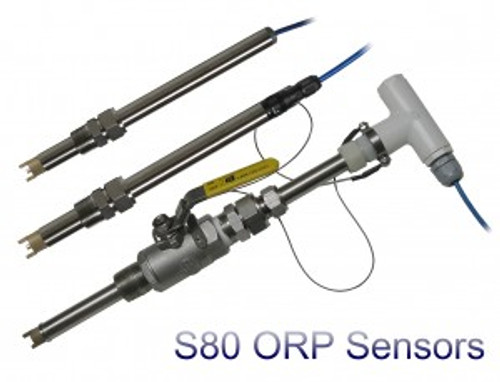Product Overview
S80 Resistivity Sensors – the ECD Advantage
- Intelligent Sensor: Stores Identity and Calibration Information
- Insertion/Submersion with adjustable gland fittings and Valve Retractable Designs
- Wide Variety of Materials of Construction
Specifications for the S80 Resistivity Sensors
- Measurement range: 0.00-50.00 meg-ohms
- Temperature range: -20° – 130°C
- Wetted Materials: 316L SS, PEEK, VITON
The S80 Resistivity Sensors are one part of the Model S80 Intelligent Sensors product line. The S80 Sensors offering includes pH Sensors, ORP Sensors, Ion Selective Sensors, Dissolved Oxygen Sensors, Conductivity Sensors and Resistivity Sensors. The S80 sensors have two Universal Sensor Designs; Insertion/Submersion or Valve Retractable with flared end to prevent blow out. The standard S80 sensors have 316 Stainless Steel housings although various materials of construction are available to maximize sensor performance while minimizing cost of ownership. For other materials of construction request a quotation from the factory.
The S80 Resistivity Sensors convert the analog signals from the electrode cartridge into a digital protocol that allows two way communications with the transmitter. The type of sensor, identity and serial number, are stored in the sensor’s memory along with three calibration registers. When connected to an ECD digital analyzer the sensor’s information is uploaded to the analyzer configuring the displays and outputs to the values appropriate to the sensor’s measured parameter.
The S80 Insertion Sensor uses a ¾” MNPT compression fitting as the process connection. This allows a variable insertion length to accommodate installation in pipe tees, flow cells, or through tank walls. If the fitting is reversed the sensor can be installed in a stand pipe for submersion into a tank.
The S80 Valve Retractable Sensor uses a 1” ball valve with a 1” NPT process connection. Loosening the rear compression fitting allows the sensor to slide freely through the ball valve but stop at the compression fitting preventing blow out. Then close the ball valve to either insert the S80 Resistivity Sensor into the process or retract it from the process.







